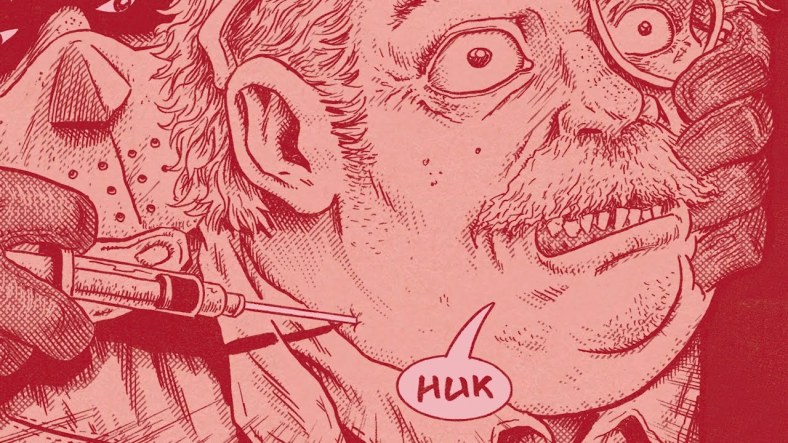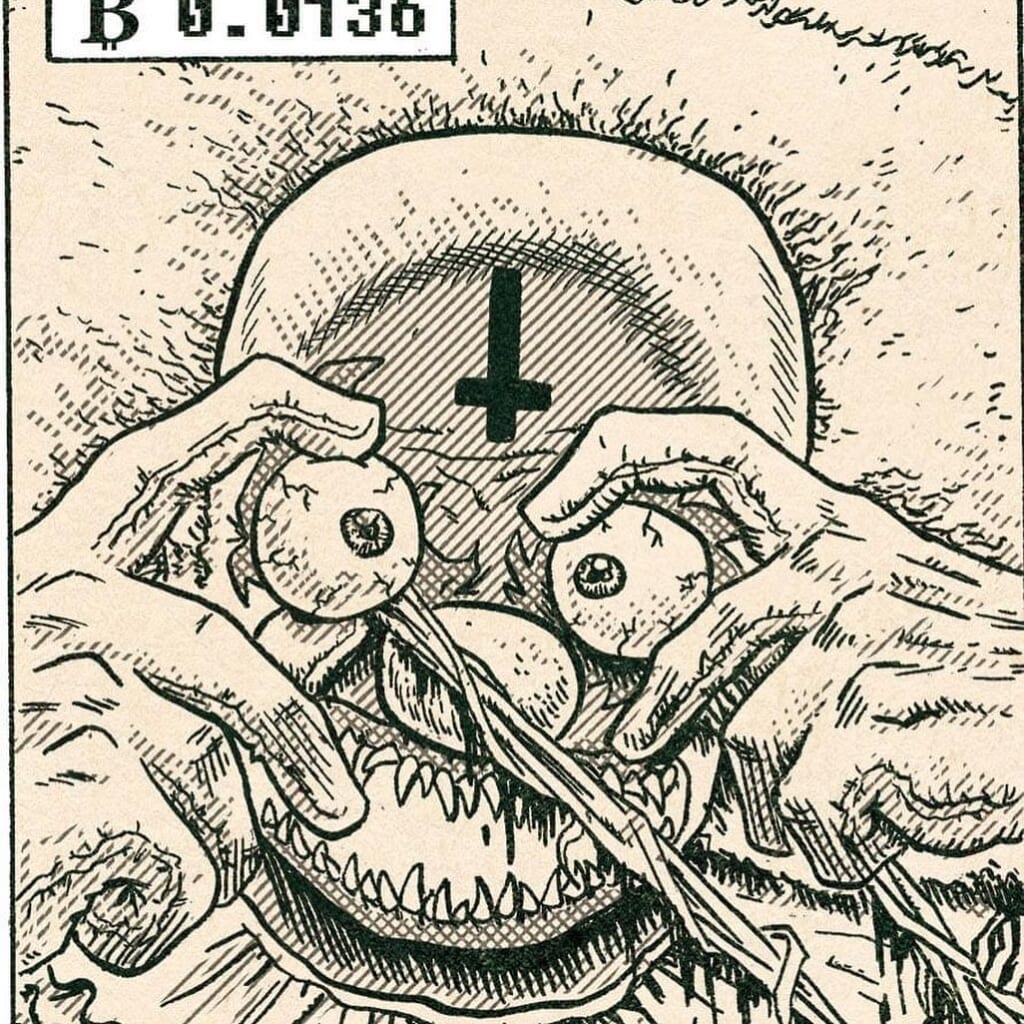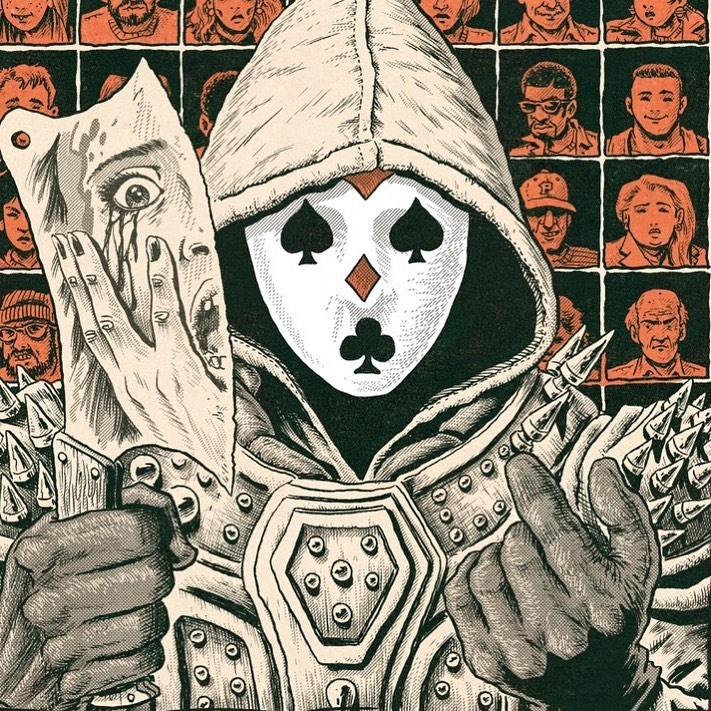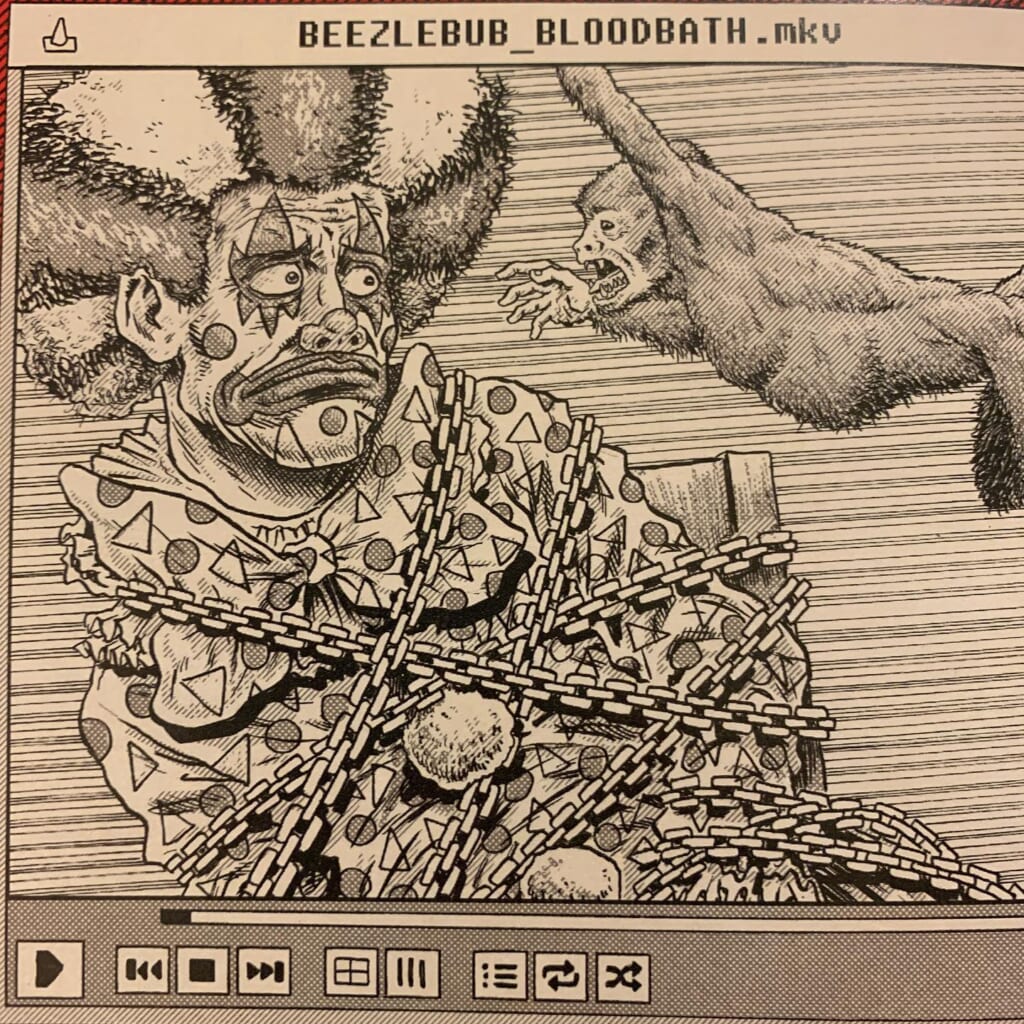The Dark Web is Decadent and Depraved: An Interview With ‘Red Room’ Writer Ed Piskor

Born, raised, and currently living in Pittsburgh, Ed Piskor’s comics have covered subjects as diverse as computer hacking, the X-Men, and the early days of hip-hop. For the past few years, though, Piskor has been working on an extreme horror comic series called Red Room. It explores the lives of performers, victims, and viewers who take part in a fictional underground live-streaming snuff video scene. The concept is based on dark web urban legends. Luckily, so far, there’s no evidence of actual masked people torturing and killing innocent victims on a livestream. Not yet, anyway.
Red Room has gone through two volumes (or “seasons” as Piskor prefers to call them), and at least one more is planned. The first season, called The Antisocial Network, has been collected into a gorgeous trade paperback from Fantagraphics. The final issue of the second season, Trigger Warnings, has just dropped and its trade paperback will be out later this year.
Inside each comic you’ll find some of the gnarliest graphic images, showcasing all sorts of creative ways to pull out eyes, stretch limbs, pull rib cages apart, and pretty much any other kind of mutilation you can inflict on the human body.
Of course, the books are so much more than their exceptionally drawn gore. The storytelling is top-notch and the characters are all fully fleshed out (pun intended). Each of the Red Room executioners is dressed, appropriately, like a comic supervillain to hide their identities from the world at large. It’s an intriguing premise, and even better in its execution.
Each issue of Red Room is self-contained, so unlike most modern comics, you can jump in at any point without having to know sixty years of backstory. So it’s also one of the most reader-friendly comics I’ve come across in a long time.
I had a blast interviewing Ed Piskor, and I think you’ll get a kick out of it, too.
Dread Central: Your stories are all self-contained, but they feed into a larger narrative. Do you have any master plan for [Red Room], as far as plotting and all that?
Ed Piskor: Not really, man. I can just handle one issue at a time, putting all of my effort into each issue, with no grand scheme. There’s not going to be some final issue where it all comes together in some epic finale or something. That’s not the style. It’s just like, “Here’s a problem that is introduced upon the world, and let’s look at that problem through a bunch of different angles.”
DC: Each season has its own little arc, too.
EP: Do you think? I don’t think about that consciously, to be honest.
DC: Especially the last season. If [the series] ended there, that would make a fine ending.
EP: Oh, right. The hope is that each issue is completely satisfying. They could come into the fold and dig it. But if they read them all, it will be much more fleshed out and they’d get more out of it if that makes sense.
DC: Oh, yeah. Do you have any plans about how far you’re going to go with this before you start a new project?
EP: Oh, I have the first issue of the next [season] finished. I have three more to do. I’m working on the second one now. And then after I finish these, I’m going to explore some other ideas. A little palate cleanser. You can’t keep your mind in a Red Room universe for too long.
DC: Horror has been quite a departure, it seems, from your earlier work. Did it take any of your long-time readers by surprise when you decided this was going to be your next project?
EP: I think really my career is playing out the way some of my favorite cartoonists’ careers played out. So unlike somebody like say, Jaime or Gilbert Hernandez, who explore the same characters their entire career, there are guys like Dan Clowes. There’s an audience for Ghost World, there’s an audience for Wilson, there’s an audience for Ice Haven, and then there’s a smaller percentage of people who are Dan Clowes fans. I think that’s how my career is playing out. There are people who dig Hip Hop Family Tree, people who dig the X-Men stuff. I’m definitely seeing new faces with Red Room. And then there will be a small percentage of the crowd that are Ed Piskor people who will check out whatever I put together. But that’s a smaller number.
DC: I suppose some people would call this extreme horror. What made you want to push things all the way, so to speak, on your first major foray into horror?
EP: It’s just a simple function of doing whatever everybody else isn’t. And a lot of people are real scared these days, living in fear of the online mobs and shit. So there are a lot of placid comics out there, and I did not grow up with that kind of shit. I grew up with Faust, and I grew up with some hardcore stuff. I’m a kid from the ’90s, dude. And my folks, they never censored shit. I watched Freddy Kruger movies and all that stuff from the youngest age. So that’s the cloth that I’m cut from, and I’m just going to bring that back. I don’t care if people support it necessarily. It’s just like, “Let’s get one hardcore comic on the racks, because a lot of cartoonists are really shy and nervous about offending people.” I’m not going out of my way to mess with any particular group or type of person or anything. But the comic is called Trigger Warning and if you picked it up and you’re going to cry like a little bitch, no problem.

DC: It seems in a way that you’re going to, maybe not intentionally either, but to offend just about everybody, in some way.
EP: No sacred cows, man.
DC: Yeah, and I’m pretty jaded. I’ve seen a ton of horror myself, so not a lot got to me until that dog.
EP: Yeah, yeah, there’s that. It’s funny, because before that I gave myself certain rules like, “No kids, no animals,” whatever. And then it just felt too perfect. What if a kid does the animal in?
DC: I do appreciate you getting those emotions out of me for the first time in quite a while.
EP: You know, it even works on me, to be honest. Because I will sit at my blank page and part of the job is to daydream and gross myself out, and then that’s when it gets committed to paper.
DC: Do you do a written outline at all for the story part? Or do you just go straight into sketching and the story follows like that?
EP: It will be like bullet points. So I have at least 22 pages per issue, up to about 32, and I will just have numbered lines. Twenty-two lines on a sheet, and just come up with little sentences for what’s happening on each page, rearrange them, and then when it comes time to do that page, I just spend the whole day thinking about how to best visually express that sentence. And things change along the way. I have to keep it liquid to stay motivated and to keep having fun. It has to be a constant discovery. If it’s in stone upfront, it’s almost like all the creative capital has been expended, and what’s the point. So keep everything a little loosey goosey until the very end. And that even includes, in the end, I’ll rewrite text and stuff, as I reread through the comic. Then I’ll go back, give it another polish.
DC: Your comic isn’t explicitly political, but there is a lot of stuff about class consciousness and sometimes in pretty stark terms, because the performers are lower to middle class and obviously the people who watch it, the only people who can afford it, are rich. Did you mean it to be so class-conscious? Or did it evolve that way?
EP: It did evolve that way. Trying to logically think this kind of world out, I just can’t help but think of the man and woman who has everything, right? They would all be pussies and not want to kill somebody themselves or do dirt themselves. So to watch it on a screen gives them that remove and they have the money to facilitate that sort of stuff.
When that Jeffrey Epstein dude got in trouble the first time and he got off with a slap on the wrist, I did not forget that. I saw that shit. And it’s like, “Okay, so you’ve got a billion dollars, you could do whatever.” It was only when he rubbed their faces in it a second time that they were like, “All right, we’ve actually got to arrest this dude now.” And I feel like he would’ve been a Red Room participant, putting money down for that kind of shit. And those guys, it’s a particular kind of mental illness, to have a billion dollars, and I could imagine those people doing that.
But then on the other side of the spectrum, there would be the people who would traffic in those videos, who would get just the trickle-down dregs of whatever recordings were allowed to be leaked. And of course, those people would get in trouble and have their whole lives ruined forever, have a black mark, a scarlet letter on their name forever, and shit like that. That seems perfectly American.

DC: The power elite is just watching this violence through screens, causing this violence in a way, but also being passive and further distancing themselves emotionally.
EP: Yeah, exactly. Like it’s not real. You have that removal, like it’s watching an MMA fight or something. And then it’s in those chat rooms, which are some of my favorite stuff to write in the series. It’s just like everybody is a Patrick Bateman. What they’re talking about is where their summer houses are and shit, and where the best Michelin star restaurant is in Paris and junk. And just not even talking about the stuff at hand. They’re just talking about bourgeois bullshit.
DC: As a reader, I think it’s fun that we get a different [aesthetic] style, at least a little bit, in each issue.
EP: Well, I think that’s just a function of learning to draw better. Just continuing to practice and try to figure out how to make better work, man. So I appreciate you saying that. My comics are an exercise, and each one should be a little different. This one I’m working on right now, the storytelling structure is way different than everything else.
It could be literary, it could be the panel compositions, it could be playing around with time. There are a lot of stuff you can mess around with in comics to create a different experience, and that’s what I want with each issue, is to just read a little differently. Like that Pumpkins issue, that idea of having that running suicide letter, and that is an unreliable narrator, because the stuff in the note is divorced from the visuals you’re seeing that corresponds with it. That was on purpose.
DC: How much research did you do? Did you have to go back and look at anatomy books and stuff like that? I know you’re probably familiar with that anyway, but you get really get hardcore into anatomy sometimes with this.
EP: I’ve learned a lot about the figure while dissecting them in the comic for sure. But there’s a lot of research that’s done on the writing side also, to try to understand the dark web. How the heck do people get caught on the dark web? Reading case law and court transcripts and stuff from people who got busted messing around on the dark web, doing any number of ridiculous crimes. There’s a lot of stuff that goes into it, and that’s why it’s like, after I get done with these last three issues. It’s like I’m doing something completely opposite to just have some sanity. It wasn’t until I started making this comic that there were two times when I woke up screaming.
DC: Oh my God.
EP: Yeah. And that’s never happened to me in my whole life. So, there’s definitely some subconscious stuff that’s going on by just playing around in this sandbox.
DC: With social media the way it is, we don’t really need Red Rooms for snuff, do we?
EP: Oh, yeah. That’s the truth, man. And that’s the thing too. I definitely don’t want to encourage it, but since I started making the comic, people are like… thinking they’re being helpful by sending me the latest cartel footage and shit.
DC: So I recently saw the Red Room short film that [Jason Baker and Aaron J. Shelton] made. How’d that come about?
EP: Yeah man, that’s a special effects company here in Pittsburgh, affiliated with Tom Savini, and they just reached out, like, “Yo, we like Red Room. Can we make a Red Room?” And fuck yeah, I wanted to see that. It was cool because it was done on a homeboy level where you don’t have to get lawyers involved to do all that stuff, because that was my thing. It’s like, “Dude, I can’t sign any papers,” because then I’ll have to have my lawyer check it out. Like, “If we’re going to do it, go do it. Let’s see what that looks like. Why not?” And I think it turned out great. It’s hard for me to watch. It makes me happy that my thing is just a comic, drawings on paper, because to hear screams and junk, it does something to your physiology.
DC: What kinds of stuff were you interested in when you were growing up, as far as horror movies?
EP: Troma was huge for me. I still remember when my folks got a VCR and it was the era of the mom-and-pop video store. We lived on 12th Ave, and the video store was on 8th Ave. We went to Best Video, opening the door and there was a poster of Toxic Avenger on the wall, and I’m looking at my pop it’s like, “Dad, we got to see that flick.” And he was like, “Yeah son, I think we need to see that flick.” We were both in awe of that shit, dude.
I was conceived at a double screening. It was Attack of the Killer Tomatoes and Texas Chain Saw Massacre.
DC: Okay, that’s pretty awesome. You really seem to have a fascination of how malleable the human body is, and how it can stretch and move and other stuff. Have you enjoyed these experiments??
EP: It’s just pushing my drawing chops. And thinking of something super uncomfortable and actually trying to visualize it. It’s a real challenge that I set up for myself and I want to try not to be just one note with it and keep messing around and figure new freaky images out as much as possible/ But it all starts with that blank page, knowing that I have to fill it up with something atrocious. It could take a day of just daydreaming, and ultimately just like, “Ugh.” I just freak myself out and that’s when I know it’s time to commit it to paper, man.

DC: You mentioned waking up screaming earlier. Is it your own stuff that gave you nightmares? Or more the real-life stuff that you’ve researched?
EP: I think it’s just the spirit. I think it’s the head space that you’re in. As hard as I try, I can’t come up with a good motivation to kill somebody. As much as I try, I can’t think of a reason to do that, especially for just a money motive. That’s such a leap. But you have to try to get inside these characters and figure out why they would do such a thing.
So my head’s in that place all day. And it just overwhelmed my slumber.
DC: Even the nicest people in [Red Room] have some shadow material that you’re exploring.
EP: Yeah. I think that’s a theme also, because even the most innocent [Red Room characters], Brianna and her home girl, still at least hide drug use and shit from their folks.
DC: Yeah. It’s all about what these people do when they’re all alone.
EP: Right. And in this modern world where there are people who are just very quick to jump on the bandwagon, try to destroy other people’s lives, if you examine their lives, I’m sure that there’s some unsavory behavior going on. Because everybody has something.
DC: Is that a cynical way to look at things, you think?
EP: Yeah, I don’t know. Maybe.
DC: I think I agree with you. But at the same time I’m hoping there are people out there who just go home and think about changing the world for the better or something.
EP: I think that also, but what I’m saying is that those people that you described are not roasting people online. I’m just talking about the people that “doth protest too much” type energy. They have darkness. I’m sure of it.
Categorized:Interviews News

